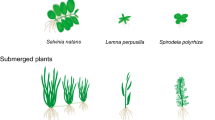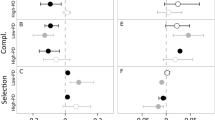Abstract
Studies investigating the impacts of biodiversity loss on ecosystem processes have often reached different conclusions, probably because insufficient attention has been paid to some aspects including (1) which biodiversity measure (e.g., species number, species identity or trait) better explains ecosystem functioning, (2) the mechanisms underpinning biodiversity effects, and (3) how can environmental context modulates biodiversity effects. Here, we investigated how species number (one to three species) and traits of aquatic fungal decomposers (by replacement of a functional type from an unpolluted site by another from a metal-polluted site) affect fungal production (biomass acumulation) and plant litter decomposition in the presence and absence of metal stress. To examine the putative mechanisms that explain biodiversity effects, we determined the contribution of each fungal species to the total biomass produced in multicultures by real-time PCR. In the absence of metal, positive diversity effects were observed for fungal production and leaf decomposition as a result of species complementarity. Metal stress decreased diversity effects on leaf decomposition in assemblages containing the functional type from the unpolluted site, probably due to competitive interactions between fungi. However, dominance effect maintained positive diversity effects under metal stress in assemblages containing the functional type from the metal-polluted site. These findings emphasize the importance of intraspecific diversity in modulating diversity effects under metal stress, providing evidence that trait-based diversity measures should be incorporated when examining biodiversity effects.



Similar content being viewed by others
References
Azevedo MM, Cássio F (2010) Effects of metals on growth and sporulation of aquatic fungi. Drug Chem Toxicol 33:269–278. doi:10.3109/01480540903431440
Balvanera P, Pfisterer AB, Buchmann N, He J-S, Nakashizuka T, Raffaelli D, Schmid B (2006) Quantifying the evidence for biodiversity effects on ecosystem functioning and services. Ecol Lett 9:1146–1156. doi:10.1111/j.1461-0248.2006.00963.x
Bärlocher F (2005) Freshwater fungal communities. In: Dighton J, Oudemans P, White J (eds) The fungal community, 3rd edn. CRC Press, Boca Raton
Bärlocher F, Corkum M (2003) Nutrient enrichment overwhelms diversity effects in leaf decomposition by stream fungi. Oikos 101:247–252. doi:10.1034/j.1600-0706.2003.12372.x
Bärlocher F, Graça MAS (2002) Exotic riparian vegetation lowers fungal diversity but not leaf decomposition in Portuguese streams. Freshwater Biol 47:1123–1135. doi:10.1046/j.1365-2427.2002.00836.x
Bermingham S, Maltby L, Dewey FM (1996) Monoclonal antibodies as tools to quantify mycelium of aquatic hyphomycetes. New Phytol 132:593–601. doi:10.1111/j.1469-8137.1996.tb01878.x
Callaway RM, Brooker RW, Choler P, Kikvidze Z, Lortiek CJ, Michalet R, Paolini L, Pugnaire FI, Newingham B, Aschehoug ET, Armas C, Kikodze D, Cook BJ (2002) Positive interactions among alpine plants increase with stress. Nature 417:844–848. doi:10.1038/nature00812
Cardinale BJ, Srivastava DS, Duffy JE, Wright JP, Downing AL, Sankaran M, Jouseau C (2006) Effects of biodiversity on the functioning of trophic groups and ecosystems. Nature 443:989–992. doi:10.1038/nature05202
Dang CK, Chauvet E, Gessner MO (2005) Magnitude and variability of process rates in fungal diversity-litter decomposition relationships. Ecol Lett 8:1129–1137. doi:10.1111/j.1461-0248.2005.00815.x
Das M, Royer TV, Leff LG (2007) Diversity of fungi, bacteria, and actinomycetes on leaves decomposing in a stream. Appl Environ Microbiol 73:756–767. doi:10.1128/AEM.01170-06
Duarte S, Pascoal C, Cássio F, Bärlocher F (2006) Aquatic hyphomycete diversity and identity affect leaf litter decomposition in microcosms. Oecologia 147:658–666. doi:10.1007/s00442-005-0300-4
Duarte S, Pascoal C, Garabétian F, Cássio F, Charcosset J-Y (2009) Microbial decomposer communities are mainly structured by trophic status in circumneutral and alkaline streams. Appl Environ Microbiol 79:6211–6221. doi:10.1128/AEM.00971-09
Ducklow H (2008) Microbial services: challenges for microbial ecologists in a changing world. Aquat Microb Ecol 53:13–19. doi:10.3354/ame01220
Falkowski PG, Fenchel T, Delong EF (2008) The microbial engines that drive Earth’s biogeochemical cycles. Science 320:1034–1039. doi:10.1126/science.1153213
Fernandes I, Duarte S, Cássio F, Pascoal C (2009a) Mixtures of zinc and phosphate affect leaf litter decomposition by aquatic fungi in streams. Sci Total Environ 407:4283–4288. doi:10.1016/j.scitotenv.2009.04.007
Fernandes I, Uzun B, Pascoal C, Cássio F (2009b) Responses of aquatic fungal communities on leaf litter to temperature-change events. Int Rev Hydrobiol 94:410–418. doi:10.1002/iroh.200811163
Ferreira V, Gulis V, Graça MAS (2006) Whole-stream nitrate addition affects litter decomposition and associated fungi but not invertebrates. Oecologia 149:718–729. doi:10.1007/s00442-006-0478-0
Fox JW (2005) Interpreting the ‘selection effect’ of biodiversity on ecosystem function. Ecol Lett 8:846–856. doi:10.1111/j.1461-0248.2005.00795.x
Gamfeldt L, Hillebrand H (2008) Biodiversity effects on aquatic ecosystem functioning—maturation of a new paradigm. Int Rev Hydrobiol 93:550–564. doi:10.1002/iroh.200711022
Gamfeldt L, Källström B (2007) Increasing intraspecific diversity increases predictability in population survival in the face of perturbations. Oikos 116:700–705. doi:10.1111/j.0030-1299.2007.15382.x
Gessner MO (2005) Ergosterol as a measure of fungal biomass. In: Graça MAS, Bärlocher F, Gessner MO (eds) Methods to study litter decomposition: a practical guide. Springer, Dordrecht, pp 189–196
Hector A, Bell T, Connolly J, Finn J, Fox J, Kirwan L, Loreau M, McLaren J, Schmid B, Weigelt A (2009) The analysis of biodiversity experiments: from pattern toward mechanism. In: Naeem S, Bunker DE, Hector A, Loreau M, Perrings C (eds) Biodiversity, ecosystem functioning, and human wellbeing. An ecological and economic perspective. Oxford University Press, New York, pp 94–104
Hooper DU, Chapin FS III, Ewel JJ, Hector A, Inchausti P, Lavorel S, Lawton JH, Lodge DM, Loreau M, Naeem S, Schmid B, Setälä H, Symstad AJ, Vandermeer J, Wardle DA (2005) Effects of biodiversity on ecosystem functioning: a consensus of current knowledge. Ecol Monogr 75:3–35. doi:10.1890/04-0922
Hughes AR, Stachowicz JJ (2004) Genetic diversity enhances the resistance of a seagrass ecosystem to disturbance. Proc Natl Acad Sci USA 101:8998–9002. doi:10.1073/pnas.0402642101
Hughes AR, Inouye BD, Johnson MTJ, Underwood N, Vellend M (2008) Ecological consequences of genetic diversity. Ecol Lett 11:609–623. doi:10.1111/j.1461-0248.2008.01179.x
Jessup CM, Kassen R, Forde SE, Kerr B, Buckling A, Rainey PB, Bohannan BJM (2004) Big questions, small worlds: microbial model systems in ecology. Trends Ecol Evol 19:189–197. doi:10.1016/j.tree.2004.01.008
Kanagawa T (2003) Bias and artifacts in multitemplate polymerase chain reactions (PCR). J Biosci Bioeng 96:317–323. doi:10.1016/S1389-1723(03)90130-7
Kennedy PG, Bergemann SE, Hortal S, Bruns TD (2007) Determining the outcome of field-based competition between two Rhizopogon species using real-time PCR. Mol Ecol 16:881–890. doi:10.1111/j.1365-294X.2006.03191.x
Kominoski JS, Hoellein TJ, Kelly JJ, Pringle CM (2009) Does mixing litter of different qualities alter stream microbial diversity and functioning on individual litter species? Oikos 118:457–463. doi:10.1111/j.1600-0706.2008.17222.x
Kubista M, Andrade JM, Bengtsson M, Forootan A, Jonák J, Lind K, Sindelka R, Sjöback R, Sjögreen B, Strömbom L, Ståhlberg A, Zoric N (2006) The real-time polymerase chain reaction. Mol Asp Med 27:95–125. doi:10.1016/j.mam.2005.12.007
Lecerf A, Dobson M, Dang CK, Chauvet E (2005) Riparian plant species loss alters trophic dynamics in detritus-based ecosystems. Oecologia 146:432–442. doi:10.1007/s00442-005-0212-3
Loreau M, Hector A (2001) Partitioning selection and complementarity in biodiversity experiments. Nature 412:72–76. doi:10.1038/35083573
Marks JC, Haden GA, Harrop BL, Reese EG, Keams JL, Watwood ME, Whitham TG (2009) Genetic and environmental controls of microbial communities on leaf litter in streams. Freshwater Biol 54:2616–2627. doi:10.1111/j.1365-2427.2009.02270.x
McKie BG, Schindler M, Gessner MO, Malmqvist B (2009) Placing biodiversity and ecosystem functioning in context: environmental perturbations and the effects of species richness in a stream field experiment. Oecologia 160:757–770. doi:10.1007/s00442-009-1336-7
Mulder CPH, Uliassi DD, Doak DF (2001) Physical stress and diversity-productivity relationships: the role of positive interactions. Proc Natl Acad Sci USA 98:6704–6708. doi:10.1073/pnas.111055298
Pascoal C, Cássio F (2004) Contribution of fungi and bacteria to leaf litter decomposition in a polluted river. Appl Environ Microbiol 70:5266–5273. doi:10.1128/AEM.70.9.5266-5273.2004
Pascoal C, Cássio F (2008) Linking fungal diversity to the functioning of freshwater ecosystems. In: Sridhar KR, Bärlocher F, Hyde KD (eds) Novel techniques and ideas in mycology. Fungal Diversity Research Series, Fungal Diversity Press, Hong Kong, pp 1–15
Pascoal C, Cássio F, Marvanová L (2005a) Anthropogenic stress may affect aquatic hyphomycete diversity more than leaf decomposition in a low-order stream. Arch Hydrobiol 162:481–496. doi:10.1127/0003-9136/2005/0162-0481
Pascoal C, Marvanová L, Cássio F (2005b) Aquatic hyphomycete diversity in streams of Northwest Portugal. Fungal Divers 19:109–128
Pascoal C, Cássio F, Nikolcheva L, Bärlocher F (2010) Realized fungal diversity increases functional stability of leaf litter decomposition under zinc stress. Microb Ecol 59:84–93. doi:10.1007/s00248-009-9567-z
Raviraja NS, Sridhar KR, Bärlocher F (1998) Breakdown of Ficus and Eucalyptus leaves in an organically polluted river in India: fungal diversity and ecological functions. Freshwater Biol 39:537–545. doi:10.1046/j.1365-2427.1998.00303.x
Raviraja NS, Nikolcheva LG, Bärlocher F (2006) Fungal growth and leaf decomposition are affected by amount and type of inoculum and by external nutrients. Sydowia 58:91–104
Reiss J, Bridle JR, Montoya JM, Woodward G (2009) Emerging horizons in biodiversity and ecosystem functioning research. Trends Ecol Evol 24:505–514. doi:10.1016/j.tree.2009.03.018
Reiss J, Forster J, Cássio F, Pascoal C, Stewart R, Hirst AG (2010) When microscopic organisms inform general ecological theory. Adv Ecol Res 43:45–85. doi:10.1016/B978-0-12-385005-8.00002-2
Reusch TBH, Ehlers A, Hämmerli A, Worm B (2005) Ecosystem recovery after climatic extremes enhanced by genotypic diversity. Proc Natl Acad Sci USA 102:2826–2831. doi:10.1073/pnas.0500008102
Soares HMVM, Boaventura RAR, Machado AASC, Esteves da Silva JCG (1999) Sediments as monitors of heavy metal contamination in the Ave river basin (Portugal): multivariate analysis of data. Environ Pollut 105:311–323. doi:10.1016/S0269-7491(99)00048-2
Sridhar KR, Krauss G, Bärlocher F, Wennrich R, Krauss G-J (2000) Fungal diversity in heavy metal polluted waters in Central Germany. Fungal Divers 5:119–129
Sridhar KR, Krauss G, Bärlocher F, Raviraja NS, Wennrich R, Baumbach R, Krauss G-J (2001) Decompostion of alder leaves in two heavy metal-polluted streams in central Germany. Aquat Microb Ecol 26:73–80. doi:10.3354/ame026073
Suberkropp K, Arsuffi TL, Anderson JP (1983) Comparison of degradative ability, enzymatic activity, and palatability of aquatic hyphomycetes grown on leaf litter. Appl Environ Microbiol 46:237–244
Treton C, Chauvet E, Charcosset J-Y (2004) Competitive interaction between two aquatic hyphomycete species and increase in leaf litter breakdown. Microb Ecol 48:439–446. doi:10.1007/s00248-003-0195-8
White TJ, Bruns T, Lee S, Taylor JW (1990) Amplification and direct sequencing of fungal ribosomal RNA genes for phylogenetics. In: Innis MA, Gelfand DH, Sninsky JJ, White TJ (eds) PCR Protocols: a guide to methods and applications. Academic, New York, pp 315–322
Yachi S, Loreau M (1999) Biodiversity and ecosystem productivity in a fluctuating environment: the insurance hypothesis. Proc Natl Acad Sci USA 96:1463–1468
Zar JH (1996) Biostatistical analysis, 3rd edn. Englewood Cliffs, Prentice-Hall
Zhang Q-G, Zhang D-Y (2006) Species richness destabilizes ecosystem functioning in experimental aquatic microcosms. Oikos 112:218–226. doi:10.1111/j.0030-1299.2006.14220.x
Acknowledgments
The Portuguese Foundation for Science and Technology supported I. Fernandes (SFRH/BD/42215/2007). We are grateful to M.O. Gessner, R.O. Hall, Jr, and two anonymous reviewers for helpful comments on the manuscript.
Author information
Authors and Affiliations
Corresponding author
Additional information
Communicated by Robert Hall.
Electronic supplementary material
Below is the link to the electronic supplementary material.
Rights and permissions
About this article
Cite this article
Fernandes, I., Pascoal, C. & Cássio, F. Intraspecific traits change biodiversity effects on ecosystem functioning under metal stress. Oecologia 166, 1019–1028 (2011). https://doi.org/10.1007/s00442-011-1930-3
Received:
Accepted:
Published:
Issue Date:
DOI: https://doi.org/10.1007/s00442-011-1930-3




